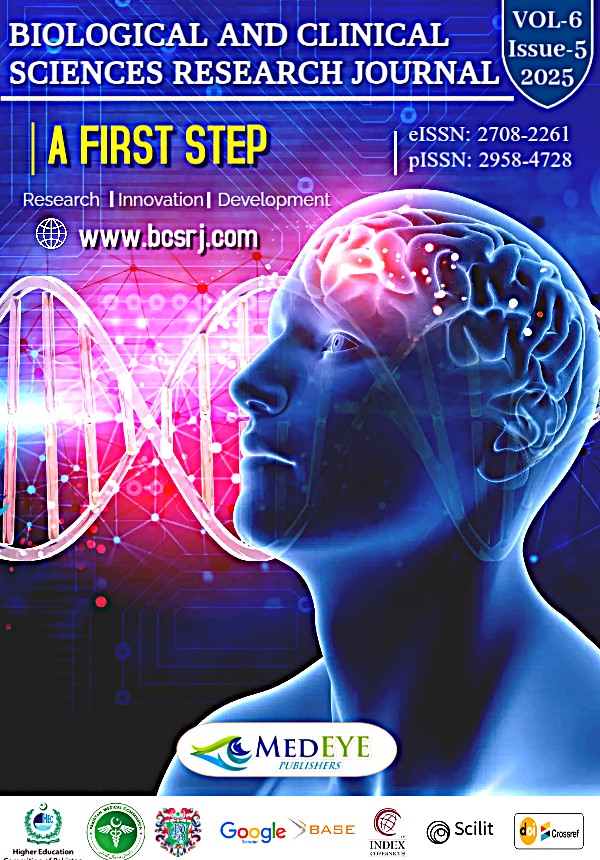Diagnostic Accuracy of Screening Mammography in Detection of Breast Neoplastic Lesion Taking Histopathology as a Gold Standard
DOI:
https://doi.org/10.54112/bcsrj.v6i5.1855Keywords:
Mammography, histopathology, accuracy, breast lesionsAbstract
Breast cancer remains the most frequently diagnosed malignancy among women worldwide, where timely and accurate detection is critical for improving survival outcomes. Mammography has long been considered the cornerstone of screening programs; however, its diagnostic performance varies with population characteristics and breast density, necessitating validation against histopathology, the gold standard for diagnosis. Objective: This study aims to evaluate the diagnostic accuracy of screening mammography in detecting breast neoplastic lesions by comparing it to histopathological results, while also assessing the impact of key clinical variables on diagnostic outcomes. Methods: After obtaining ethical approval from the institutional review board, this cross-sectional study was conducted at the Radiology department of JPMC from January 1, 2023, to June 30, 2023. Through non-probability consecutive sampling, 100 patients, aged 30 years and above, who had undergone both mammography and histopathological biopsy (core needle or excisional) for suspected breast lesions. Only cases with complete clinical records, including imaging findings, histopathology results, and relevant clinical history, were selected. Patients with incomplete records, previous diagnoses of breast cancer, or those undergoing follow-up for known malignancies were excluded. Results: The calculated sensitivity of screening mammography was 88.68%, indicating its high ability to identify patients with breast neoplastic lesions accurately. The specificity was 82.89%, reflecting its accuracy in ruling out disease in non-affected individuals. The positive predictive value (PPV) stood at 85.45%, while the negative predictive value (NPV) was 86.67%. The overall diagnostic accuracy of mammography in this study was 86.00%. Furthermore, Receiver Operating Characteristic (ROC) curve analysis was performed to evaluate the diagnostic performance of mammography. The curve demonstrated a high area under the curve (AUC = 0.728), supporting the reliability of mammography as a screening tool for breast cancer. Conclusion: Screening mammography, when benchmarked against histopathology, demonstrates high overall accuracy—with sensitivity and specificity exceeding 80%—affirming its reliability for early breast cancer detection while underscoring the importance of density-adapted, patient-tailored screening protocols.
Downloads
References
Wilkinson L, Gathani T. Understanding breast cancer as a global health concern. Br J Radiol. 2022;95(1130):20211033. https://doi.org/10.1259/bjr.20211033
Arnold M, et al. Current and future burden of breast cancer: Global statistics for 2020 and 2040. Breast. 2022;66:15-23. https://doi.org/10.1016/j.breast.2022.05.003
Ginsburg O, et al. Breast cancer early detection: A phased approach to implementation. Cancer. 2020;126(Suppl 10):2379-2393. https://doi.org/10.1002/cncr.32887
Bhushan A, Gonsalves A, Menon JU. Current state of breast cancer diagnosis, treatment, and theranostics. Pharmaceutics. 2021;13(5):632. https://doi.org/10.3390/pharmaceutics13050632
Câmara AB, Duarte LS, Cury LCPB, Wünsch-Filho V. Factors associated with false-positive screening mammography in São Paulo, Brazil. Sci Rep. 2025;15(1):4849. https://doi.org/10.1038/s41598-025-86993-x
Iranmakani S, et al. A review of various modalities in breast imaging: Technical aspects and clinical outcomes. Egypt J Radiol Nucl Med. 2020;51(1):57. https://doi.org/10.1186/s43055-020-00187-9
Mann RM, Athanasiou A, van Zelst J, et al. Breast cancer screening in women with extremely dense breasts: Recommendations of the European Society of Breast Imaging (EUSOBI). Eur Radiol. 2022;32(6):4036-4045. https://doi.org/10.1007/s00330-021-08315-7
Rashmi R, Prasad K, Udupa CBK. Breast histopathological image analysis using image processing techniques for diagnostic purposes: A methodological review. J Med Syst. 2021;46(1):7. https://doi.org/10.1007/s10916-021-01786-9
Malherbe K. Revolutionizing breast cancer screening: Integrating artificial intelligence with clinical examination for targeted care in South Africa. J Radiol Nurs. 2025;[Epub ahead of print]. https://doi.org/10.1016/j.jradnu.2024.12.004
Tadesse GF, Tegaw EM, Abdisa EK. Diagnostic performance of mammography and ultrasound in breast cancer: A systematic review and meta-analysis. J Ultrasound. 2023;26(2):355-367. https://doi.org/10.1007/s40477-022-00755-3
Shi J, Li J, Gao Y, et al. The screening value of mammography for breast cancer: An overview of 28 systematic reviews with evidence mapping. J Cancer Res Clin Oncol. 2025;151(7):[Epub ahead of print]. https://doi.org/10.1007/s00432-025-06122-z
Lee CS, Moy L, Hughes D, Golden D, Bhargavan-Chatfield M, Hemingway J, et al. Radiologist characteristics associated with interpretive performance of screening mammography: A National Mammography Database NMD study. Radiology. 2021;300(3):518-528. https://doi.org/10.1148/radiol.2021204379
Cadet MJ, Ajay G, Drago CI, Stelmark J. Understanding recommendations from various breast cancer screening guidelines. J Nurse Pract. 2025;21(1):105238. https://doi.org/10.1016/j.nurpra.2024.105238
Pisano ED, Gatsonis C, Hendrick E, et al. Diagnostic accuracy of digital versus film mammography: Exploratory analysis of selected population subgroups in DMIST. Radiology. 2008;246(2):376-383. https://doi.org/10.1148/radiol.2461070200
Sardanelli F, Bernardi D, Belli P, et al. The paradox of MRI for breast cancer screening: High-risk and dense breasts—available evidence and current practice. Insights Imaging. 2024;15(1):96. https://doi.org/10.1186/s13244-024-01653-4
Downloads
Published
How to Cite
Issue
Section
License
Copyright (c) 2025 Hina Akber Rao, Shaista Shaukat, Sumaira Shahbaz, Tariq Mahmood T.I, Asifa Akbar, Maryiam Akber

This work is licensed under a Creative Commons Attribution-NonCommercial 4.0 International License.








